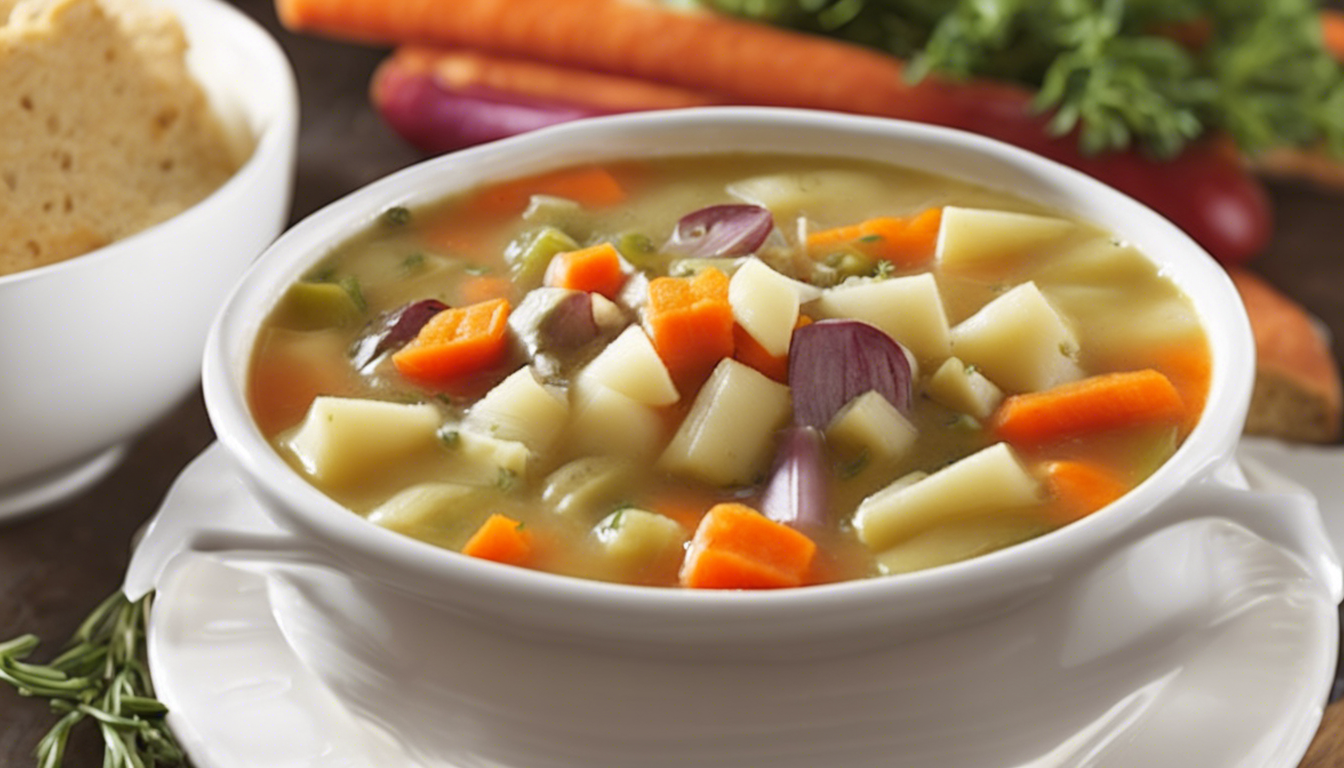
Ingredients list
Ingredients:
- 4 cups vegetable broth
- 2 large carrots, peeled and sliced
- 2 celery stalks, chopped
- 1 large onion, diced
- 3 cloves garlic, minced
- 2 medium potatoes, peeled and cubed
- 1 zucchini, chopped
- 1 cup green beans, trimmed and cut into 1-inch pieces
- 1 can (14.5 oz) diced tomatoes, with juice
- 1 cup frozen corn
- 1 cup frozen peas
- 1 teaspoon dried thyme
- 1 teaspoon dried basil
- 1 bay leaf
- Salt and pepper to taste
- 2 tablespoons olive oil
Step-by-step instructions
Step-by-step instructions:
- Step 1: Prepare the vegetables. Start by peeling and chopping all your vegetables. Slice the carrots, chop the celery, dice the onion, and cube the potatoes. Make sure the zucchini and green beans are also cut into bite-sized pieces. Mince the garlic cloves.
- Step 2: Sauté the aromatics. In a skillet, heat the olive oil over medium heat. Add the diced onion and minced garlic, and sauté for about 3-4 minutes until the onion becomes translucent and fragrant. This step helps to deepen the flavor of the soup.
- Step 3: Add ingredients to the Crock Pot. Transfer the sautéed onions and garlic into your Crock Pot. Then, add the carrots, celery, potatoes, zucchini, green beans, and frozen corn and peas. Pour in the vegetable broth and the can of diced tomatoes, including the juice.
- Step 4: Season the soup. Add the dried thyme, dried basil, and bay leaf to the Crock Pot. Season with salt and pepper to taste. Stir everything together to ensure the ingredients are well combined.
- Step 5: Cook the soup. Set your Crock Pot to low and cook for 6-8 hours, or on high for 3-4 hours. The soup is ready when the vegetables are tender and the flavors have melded together. Be sure to check the potatoes and carrots, as they take the longest to cook.
- Step 6: Adjust seasoning. Before serving, taste the soup and adjust the seasoning if necessary. You may want to add more salt, pepper, or even a dash of hot sauce for extra flavor.
- Step 7: Serve. Ladle the soup into bowls and enjoy it with a slice of crusty bread or a side salad. Remove the bay leaf before serving.
Tips for customization
Tips for customization:
This vegetable soup recipe is incredibly versatile, and you can easily adapt it to suit your taste preferences or dietary needs. Here are some ideas to help you customize the soup:
- Add more protein: If you’d like to make the soup heartier, consider adding a can of drained and rinsed beans, such as chickpeas, kidney beans, or cannellini beans. You can also add cooked lentils or quinoa for an extra boost of protein and texture.
- Switch up the vegetables: Feel free to swap out any of the vegetables listed in the recipe for your favorites or whatever you have on hand. For example, you can use sweet potatoes instead of regular potatoes, or add bell peppers, spinach, kale, or mushrooms for extra flavor and nutrients.
- Spice it up: If you enjoy a bit of heat, try adding a pinch of red pepper flakes, a dash of hot sauce, or even a chopped jalapeño to the soup. You can also experiment with different herbs and spices, such as smoked paprika, cumin, or oregano, to give the soup a unique twist.
- Make it creamy: For a creamier texture, you can blend a portion of the soup using an immersion blender or a regular blender. Alternatively, stir in a splash of coconut milk, heavy cream, or a dollop of sour cream just before serving.
- Use fresh herbs: While dried herbs work well in this recipe, fresh herbs can elevate the flavor even more. Consider adding a handful of chopped fresh parsley, cilantro, or basil just before serving for a burst of freshness.
- Boost the umami: To deepen the savory flavor of the soup, try adding a tablespoon of soy sauce, tamari, or miso paste. A splash of balsamic vinegar or a squeeze of fresh lemon juice at the end of cooking can also brighten up the flavors.
- Make it gluten-free: This recipe is naturally gluten-free, but if you’re adding any additional ingredients, such as pasta or grains, be sure to choose gluten-free options like rice, quinoa, or gluten-free pasta.
- Freeze for later: This soup freezes beautifully, making it a great option for meal prep. Allow the soup to cool completely before transferring it to airtight containers or freezer bags. It will keep in the freezer for up to 3 months. When you’re ready to enjoy it, simply thaw and reheat on the stovetop or in the microwave.
